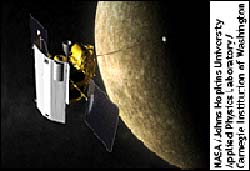This area deals with the fundamental laws and building blocks of nature and how they interact, the properties and the behavior of matter, and research into space and time and their structures.
innovations-report provides in-depth reports and articles on subjects such as astrophysics, laser technologies, nuclear, quantum, particle and solid-state physics, nanotechnologies, planetary research and findings (Mars, Venus) and developments related to the Hubble Telescope.

One of the ingenious instruments on board Rosetta is designed to ’smell’ the comet for different substances, analysing samples that have been ’cooked’ in a set of miniature ovens.
ESA’s Rosetta will be the first space mission ever to land on a comet. After its lander reaches Comet 67P/Churyumov-Gerasimenko, the main spacecraft will follow the comet for many months as it heads towards the Sun. Rosetta’s task is to study comets, which are considered the

The International Committee for Future Accelerators (ICFA), meeting during an international physics conference here, today (August 20) endorsed the recommendation of a panel of physicists charged to recommend the technology choice for a proposed future international particle accelerator.
The 12-member International Technology Recommendation Panel, chaired by Barry Barish of the California Institute of Technology, recommended that the world particle physics community adopt supercondu

As her PhD defended at the Public University of Navarre, telecommunications engineer Ixone Arroabarren has analysed the vibrato, one of the most important tools of classical singers.
The study applies both to the teaching of singing in music as well as to the medical treatment of voice pathologies. It has put forward a mathematical model for the production of the voice that can be used both in the medical study/detection of pathologies of the vocal chords and speech as well as the

VLT Observations of Beryllium in Two Old Stars Clock the Beginnings
Observations by an international team of astronomers with the UVES spectrometer on ESO’s Very Large Telescope at the Paranal Observatory (Chile) have thrown new light on the earliest epoch of the Milky Way galaxy.
The first-ever measurement of the Beryllium content in two stars in a globular cluster (NGC 6397) – pushing current astronomical technology towards the limit – has made it possible to study the ea

Two new moons orbiting between Mimas and Enceladus, discovered by the NASA/ESA/ASI Cassini-Huygens spacecraft, may be the smallest bodies so far seen around the ringed planet.
The moons are approximately three kilometres and four kilometres across. Located 194 000 kilometres and 211 000 kilometres from the planet’s centre, the moons are between the orbits of two other Saturnian moons, Mimas and Enceladus. They are provisionally named S/2004 S1 and S/2004 S2, bringing the current

The first spacecraft intended to orbit Mercury was launched on Aug. 3, 2004, carrying an instrument for mapping the composition of the planet’s crust that was calibrated with a novel procedure at the National Institute of Standards and Technology (NIST). The procedure, using NIST-produced, high-energy gamma rays, enabled the device to be prepared for the same intense radiation levels typically produced in outer space.
Mercury is a rocky planet like the Earth but smaller, denser and